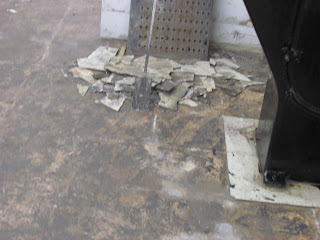Future Environment Designs (FEDTC) would like to wish all of you a Merry Holiday and a Happy New Year! We look forward to seeing all of you in the New Year. In September, FEDTC attended the 2017 Leadership, Innovation, Technology, & Evolution (#LITE2017) annual conference in
Edinburgh, Scotland. We attended last year's #LITE2016 conference and wrote about our experience (see
Future Environment Designs Attends the LITE 2016 Conference & Is Inspired!). The conference is run by
Administrate, which is the company now handling our training and customer administration. As many of you know, we use Administrate to provide you digital access to our course manual. Because of the information we learned this year, you now have access to the exam review slides we use in our classes. We now offer a few
Occupational Safety and Health Administration (OSHA) courses online (i.e., respirator users and asbestos awareness) and on adding more. What attracted us to the LITE conference this year was our desire to delve deeper into the Administrate program and to learn best practices in managing our business. This year the conference exceeded those goals. This year there weren't as many inspiring speakers, but many of the speakers gave us fundamental knowledge of the Administrate program and its capabilities.
 |
| View from Administrate's Offices |
Like last year, the conference followed two tracks Evolution and Innovation, which we mixed and matched the various presentations throughout both days. All the presentations from the conference can be seen at
Administrate's website. It started with opening remarks from
John Peebles the CEO of Administrate, filling us in on Administrate's growth in the United States (based out of
Bozeman, Montana) and in the Middle East (based out of
Beirut, Lebanon). Followed by Mike McGrail (@Mike_McGrail, formerly of Administrate and now with Velocity Digital, no kilt this time), speaking on "Busting Modern Marketing Myths". We then listened to Simon Greany, of Elucidat, discuss "Big Learning: 4 Strategies to Help You Unlock New Revenue Streams with Digital Learning."
 |
| Natasha Serafimovska Presentation on Financial Reporting |
Many of the presentations afterwards were delving into the inner workings of the Administrate programs. These presentations helped us get the best out of the program or gave us ideas of how to improve the information we get from the program. For example, the presentation by Siobhain Murdoch and our Account Rep Natasha Serafimovska, both from Administrate, discussed "Common Course Pricing Strategies for Training Companies." From their presentation we learned about creating subscriptions, how training tokens work and how to offer them. Siobhain Murdoch then joined together with Loki Lau, of Administrate, to discuss "A Deep Dive Into Course Templates," which taught us how to improve the course templates and in particular adding photos to the templates. Gilles Bell's, of Administrate, presentation on "How to Communicate More Effectively With Students and Customers" provided some ideas we will be implementing with our communications moving forward (first changes will be with the Safety Suzy Newsletter coming out before the end of this month). The second day started with a 1-2-1 session with our Account Rep Natasha Serafimovska to help us better understand the program and create several reports. Mark Mullen & Jesse Vernon, both of Administrate, discussed "How to Improve
Instructor Led Training (ILT) with
eLearning" which made us realize we can significantly improve the materials we are providing you online.
 |
| Ryan Cochrane's presentation on Creating Content That Converts to Leads |
Based on the information we learned we have already made several improvements. For all asbestos refresher courses the manual is online as many of you know already. In addition, the review for all the asbestos refresher exams is now online, too. We've created our first online course the
respirator user course. This course is required annually by anyone who uses a respirator. This will allow you to take the respirator user course "At Your Convenience." We plan on adding more courses and creating a separate landing page for the "Training At Your Convenience" service, that will include all the different ways we can train your employees, conveniently. These improvements will help FEDTC continue to improve and offer more ways in meeting our goal of Keeping Your Employees Safe!







 New York State Mold Licensing & Minimum Standards Law Is Signed By Governor Cuomo(futureenv.blogspot.com)
New York State Mold Licensing & Minimum Standards Law Is Signed By Governor Cuomo(futureenv.blogspot.com) NYS Mold Law Changes, Licensing Requirement Goes Into Effect January 1, 2016(futureenv.blogspot.com)
NYS Mold Law Changes, Licensing Requirement Goes Into Effect January 1, 2016(futureenv.blogspot.com) Future Environment Designs Approved For All NYS DOL Mold Courses(futureenv.blogspot.com)
Future Environment Designs Approved For All NYS DOL Mold Courses(futureenv.blogspot.com)


 EPA official says the agency has shrunk to Reagan-era levels(businessinsider.com)
EPA official says the agency has shrunk to Reagan-era levels(businessinsider.com) OSHA Fines Increase By 78%, Will That Lead To An Increase in Safety Consulting & Training?(futureenv.blogspot.com)
OSHA Fines Increase By 78%, Will That Lead To An Increase in Safety Consulting & Training?(futureenv.blogspot.com) PACNY's Environmental Conference - Day 1 - And So It Begins!(futureenv.blogspot.com)
PACNY's Environmental Conference - Day 1 - And So It Begins!(futureenv.blogspot.com) PACNY's Environmental Conference - The NYSDOL Round Table - Day Three and So It Ends!(futureenv.blogspot.com)
PACNY's Environmental Conference - The NYSDOL Round Table - Day Three and So It Ends!(futureenv.blogspot.com)


 32-pound king caught during tournament highlights hot salmon fishing(mlive.com)
32-pound king caught during tournament highlights hot salmon fishing(mlive.com) PACNY's Second Annual ProAm Fishing Derby, is Bigger & Better!(futureenv.blogspot.com)
PACNY's Second Annual ProAm Fishing Derby, is Bigger & Better!(futureenv.blogspot.com) PACNY Fishing Derby Was An Adventure(futureenv.blogspot.com)
PACNY Fishing Derby Was An Adventure(futureenv.blogspot.com)

 PACNY's Environmental Conference - The NYSDOL Round Table - Day Three and So It Ends!(futureenv.blogspot.com)
PACNY's Environmental Conference - The NYSDOL Round Table - Day Three and So It Ends!(futureenv.blogspot.com) PACNY's Environmental Conference - Day 1 - And So It Begins!(futureenv.blogspot.com)
PACNY's Environmental Conference - Day 1 - And So It Begins!(futureenv.blogspot.com) The "S" in NIOSH(blogs.cdc.gov)
The "S" in NIOSH(blogs.cdc.gov) Asbestos Dust Sampling in New York State(futureenv.blogspot.com)
Asbestos Dust Sampling in New York State(futureenv.blogspot.com)





 PACNY's Environmental Conference - Day 1 - And So It Begins!(futureenv.blogspot.com)
PACNY's Environmental Conference - Day 1 - And So It Begins!(futureenv.blogspot.com) Is It Really Here Again! The 21st Annual PACNY Environmental Conference Starts March 1, 2017.(futureenv.blogspot.com)
Is It Really Here Again! The 21st Annual PACNY Environmental Conference Starts March 1, 2017.(futureenv.blogspot.com) OSHA Fines Increase By 78%, Will That Lead To An Increase in Safety Consulting & Training?(futureenv.blogspot.com)
OSHA Fines Increase By 78%, Will That Lead To An Increase in Safety Consulting & Training?(futureenv.blogspot.com)
 Workers Memorial Day Message 2016(blogs.cdc.gov)
Workers Memorial Day Message 2016(blogs.cdc.gov) OSHA Fines Increase By 78%, Will That Lead To An Increase in Safety Consulting & Training?(futureenv.blogspot.com)
OSHA Fines Increase By 78%, Will That Lead To An Increase in Safety Consulting & Training?(futureenv.blogspot.com) Standing - Down to Prevent Falls in Construction(blogs.cdc.gov)
Standing - Down to Prevent Falls in Construction(blogs.cdc.gov) OSHA slams co. after 2 men died(bostonherald.com)
OSHA slams co. after 2 men died(bostonherald.com) Workplace Injury, Illness and Death- How do we know how many?(blogs.cdc.gov)
Workplace Injury, Illness and Death- How do we know how many?(blogs.cdc.gov) Memorable moments from Labor Secretary's confirmation hearing [The Pump Handle](scienceblogs.com)
Memorable moments from Labor Secretary's confirmation hearing [The Pump Handle](scienceblogs.com)




 PACNY's Environmental Conference - Day 1 - And So It Begins!(futureenv.blogspot.com)
PACNY's Environmental Conference - Day 1 - And So It Begins!(futureenv.blogspot.com) NYC's Legionnaire Outbreak Over, Leading to New Requirements for Building Owners.(futureenv.blogspot.com)
NYC's Legionnaire Outbreak Over, Leading to New Requirements for Building Owners.(futureenv.blogspot.com) NYC Legionnaires' outbreak up to 10 dead, 100 diagnosed(newsday.com)
NYC Legionnaires' outbreak up to 10 dead, 100 diagnosed(newsday.com) OSHA slams co. after 2 men died(bostonherald.com)
OSHA slams co. after 2 men died(bostonherald.com)